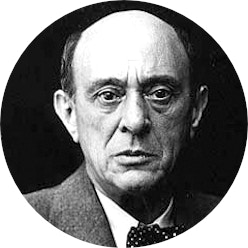
Арнольд Шёнберг
13 сентября 1874 г. - Vienna (Austria) — 13 июля 1951 г. - Los Angeles (USA)
About
Арнольд Шёнберг — мастер модернизма XX века
Автодидакт и поклонник Землинского, на сестре которого он женился, Арнольд Шёнберг сначала находился под влиянием последних мастеров романтизма: Иоганнеса Брамса, Вагнера и Малера. Его произведения конца XIX века, такие как «Просветлённая ночь», уже выражают стремление выйти за пределы позднего романтизма к новым горизонтам. Размышляя о разнообразных возможностях радикального изменения музыкального языка, Шёнберг стал одним из величайших учителей начала XX века. Альбан Берг и Веберн были его первыми учениками и сопровождали музыкальную революцию своего мастера.
Арнольд Шёнберг: изобретение додекафонии
Привыкший к скандалам, он использовал атональное письмо в 1908 году в своих «Фортепианных пьесах, Op.11», затем изобрёл додекафонию (двенадцатитоновую композицию) в 1922 году с опусом 23 и стал ещё более радикальным в выражении с серийным письмом своих «Вариаций, Op.31» несколько лет спустя. В 1933 году, чтобы избежать нацизма, он уехал в Соединённые Штаты, где провёл оставшуюся часть своей жизни.
Сначала экспрессионист с его «Пьеро Лунер» (1912) и его картинами, принадлежащими к движению «Синий всадник», основанному Кандинским, Арнольд Шёнберг на протяжении всей своей жизни искал новые пути выражения, амбициозную эстетику и современность. Он мог переходить от самого плотного лиризма к самой холодной абстракции. Шёнберг перевернул страницу романтического века и свёл величие Вагнера к уникальной и простой минуте музыки. Томас Манн, Пьер Булез и Луиджи Ноно явно заимствовали из искусства этого современного мастера для структурирования своих произведений.

